Explore the latest news and find out what's on this month
Explore our learning offer for schools, families and community groups
Uncover the rich history of Elmbridge with our latest online exhibitions
Want to discover more about your local area?
Explore the latest news and find out what's on this month
Explore our learning offer for schools, families and community groups
Uncover the rich history of Elmbridge with our latest online exhibitions
Want to discover more about your local area?
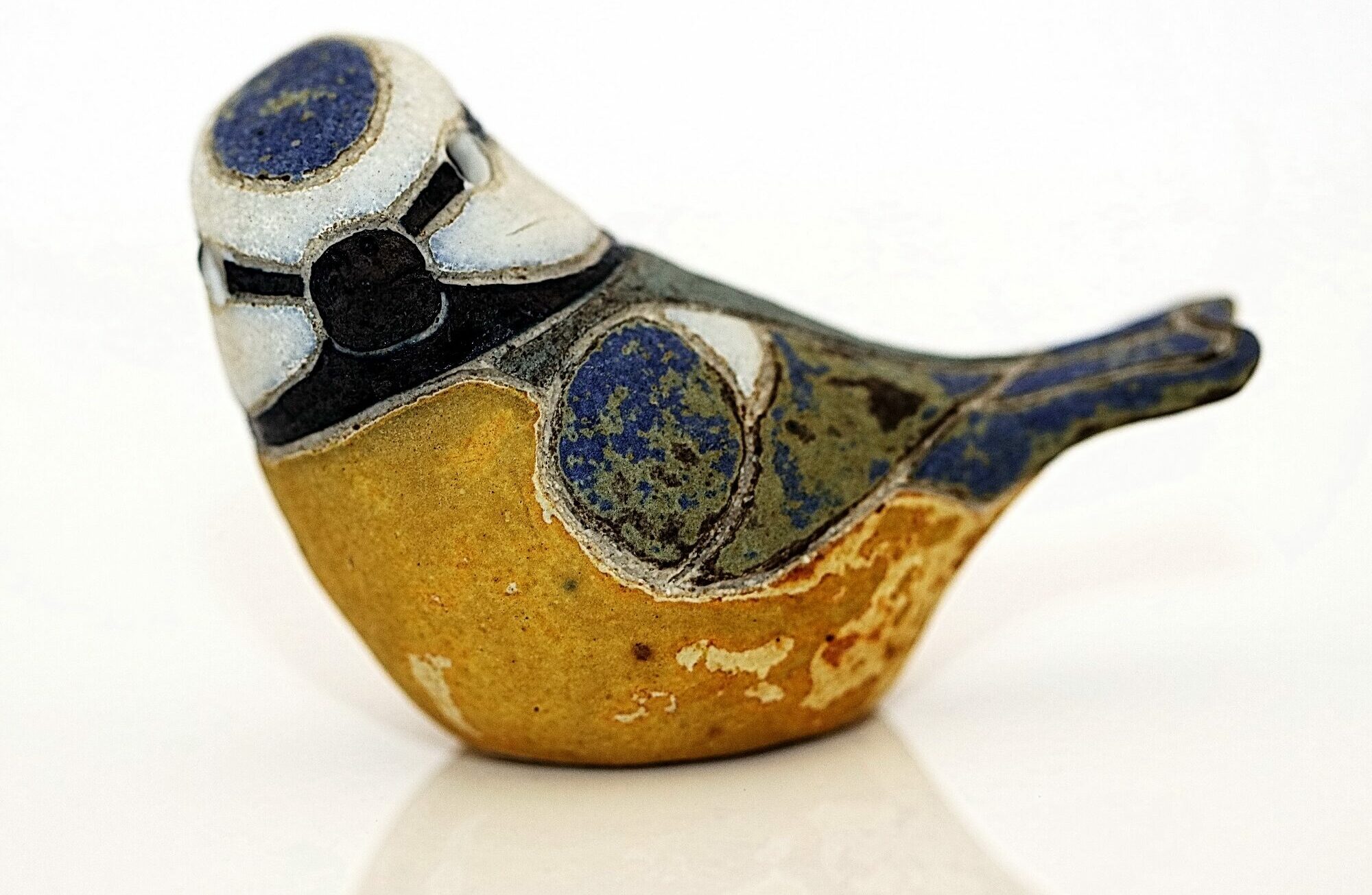 Pottery blue tit, approximately life-size, with a matt glaze, coloured blue and yellow. It is one of three pottery birds made in 1987 by Rosemary Wren and Peter Crotty from drawings from life.
Pottery blue tit, approximately life-size, with a matt glaze, coloured blue and yellow. It is one of three pottery birds made in 1987 by Rosemary Wren and Peter Crotty from drawings from life.
Denise Wren was born in Western Australia in 1891, and emigrated to England with her family in 1899. After studying under Archibald Knox at nearby Kingston, she formed the Oxshott Pottery with her husband Henry in 1920.
The Oxshott Pottery quickly gained a reputation as one of the most successful studio potteries in the country. Denise and Henry’s daughter, Rosemary, later also had a distinguished career in pottery. She had been born in 1922 and lived in Potters Croft, the house built by her parents. Rosemary trained at Guildford School of Art and started potting after serving in the Women’s Land Army.
Denise and Rosemary Wren both worked out of Oxshott Pottery until 1978, so it is interesting to compare their works which are so different yet created in such close proximity to each other. Denise had kept many animals at her Oxshott home – including dogs, cats, chickens and an aviary of birds – but it wasn’t until the 1960s that animals became present in Denise’s work. Rosemary, on the other hand, experimented with many forms but always returned to representing animals, having been exposed to them from a young age.
Denise and Rosemary Wren’s practices were, at times, radically different from one another. Denise’s vessels and traditional Ikebana (Japanese flower arranging) vases took relatively traditional forms. Rosemary’s preferred shapes, on the other hand, were stylistically ‘artistic’, informed not only by nature but also modern sculpture and her education at art school.
For Rosemary, the internal space of her hollow clay animals was just as important as the finished surface. The only openings in the whole construction are the eyes, and this is important for two reasons: not only does it let the steam out when the clay is in the kiln but, as Rosemary said, “it also allows the animal to look out”.
Rosemary Wren
It is in their tactile, hand-made strategies and the marks their works carry, however, that the two potters share common ground. Everyday objects like wooden rulers, butter knives and blunt quills were used by both potters to mark their clay works.
The hands-on approach toward mark-making displays a propensity for experimentation. Unlike artists working in other mediums – such as painters or draughtsmen – potters make very permanent and direct works; this can be seen in Denise’s goblet, pictured further down this page, which displays a hatch of scratches that are bold, beautiful and in-erasable.
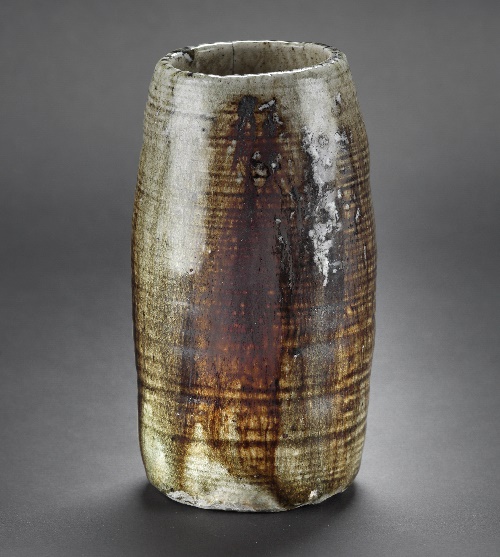
Tall jar created by Denise Wren, 1960s.
This tall jar or vase is typical of the work Denise Wren became very well-known for.
Stoneware is a popular material for many studio potters – the clay can be fired once or twice, a characteristic that Denise made the most of.
The glaze on this jar is dense and tactile, opposed to some of the thinner, running glasses Denise used. Some of Denise Wren’s main pottery production was hand-sculpted and thrown earthenware such as this, decorated with slips and glazes for flowers.
The vase was purchased from Rosemary Wren, Denise’s daughter, after a lecture on her mother’s work at Oxshott Village Hall, in 1987.
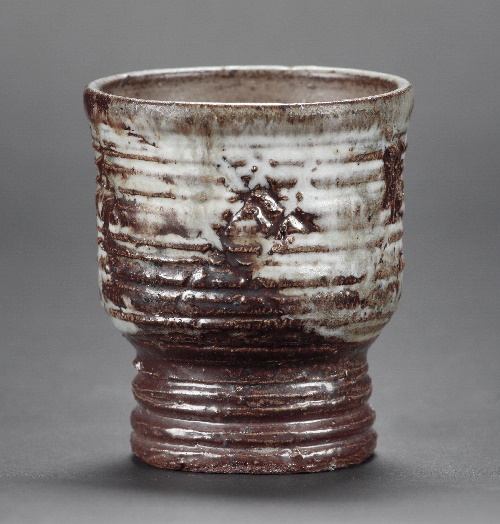
Goblet pot created by Denise Wren, 1960s.
This goblet shaped pot is known as an Ikebana pot by craftsmen potters.
The clay is decorated by incised horizontal grooves and five criss-cross patterns around the body of the pot. The glaze is of brushed white dolomite and the whole piece is fired by the salt-glaze method resulting in a brown pot, semi-glazed inside with patches of matte grey and white on the outside. On the base is a white paper label with the words “Denise K. Wren, Oxshott Pottery” in black ink. This label was put on the pot when it was exhibited in the Craftsmen Pottery Association Shop.
With the rings of its production clearly visible and scarred by the tools that Denise kept in her studio, this short goblet displays the most drastic marks in Elmbridge Museum’s Wrens pottery collection.
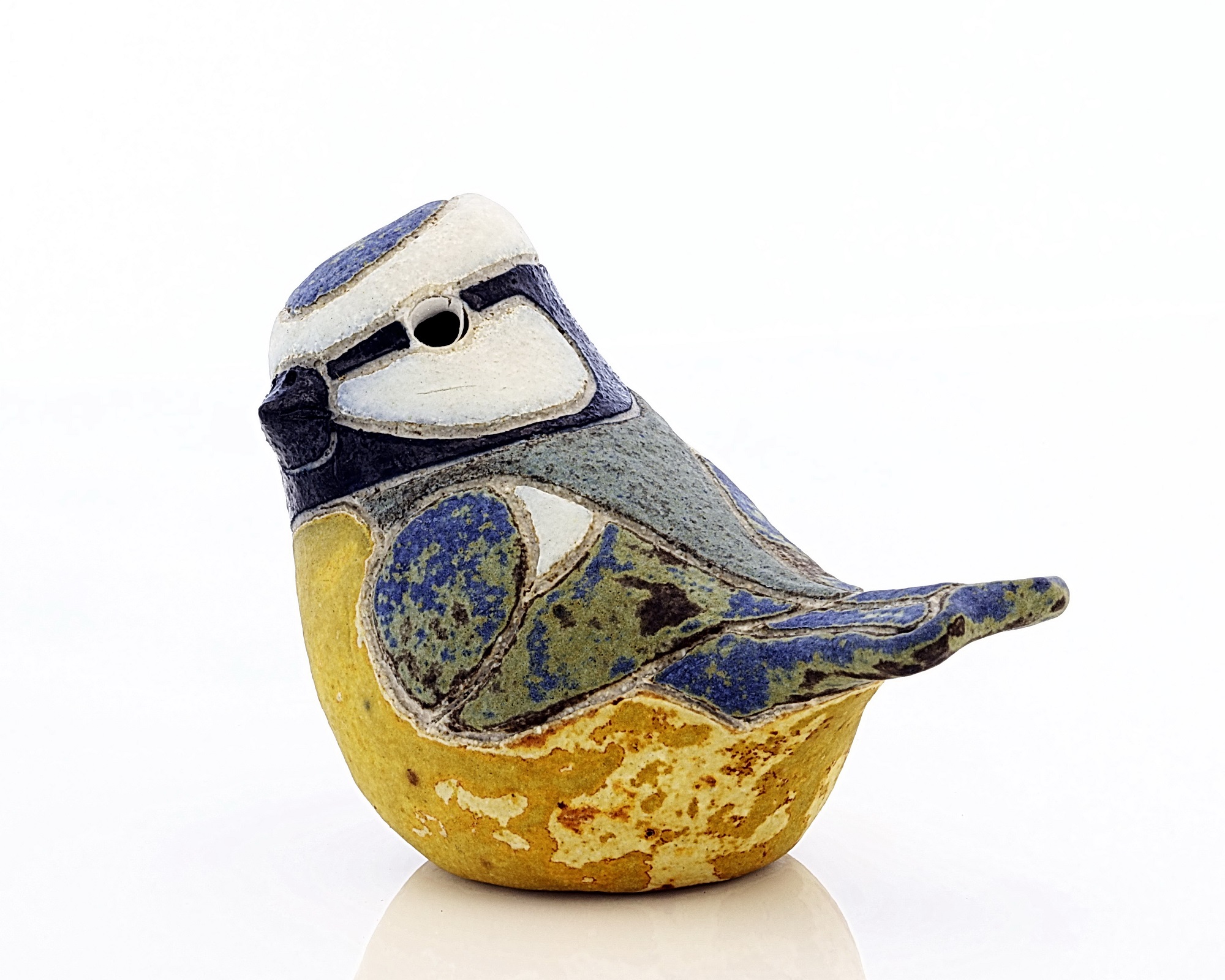
Pottery blue tit made in 1987 by Rosemary Wren and Peter Crotty.
This small blue tit was one of four similar pieces donated to Elmbridge Museum.
The sculpture is approximately life-size, with a matte glaze, coloured blue and yellow. It is one of three pottery birds made in 1987 by Rosemary Wren and Peter Crotty from life drawings of the birds.
The colouration and patterning of the bird is very accurate, but in the mannered form – the softness of the beak and the rounded tail – there is a cartoon-like and playfully animated charm.
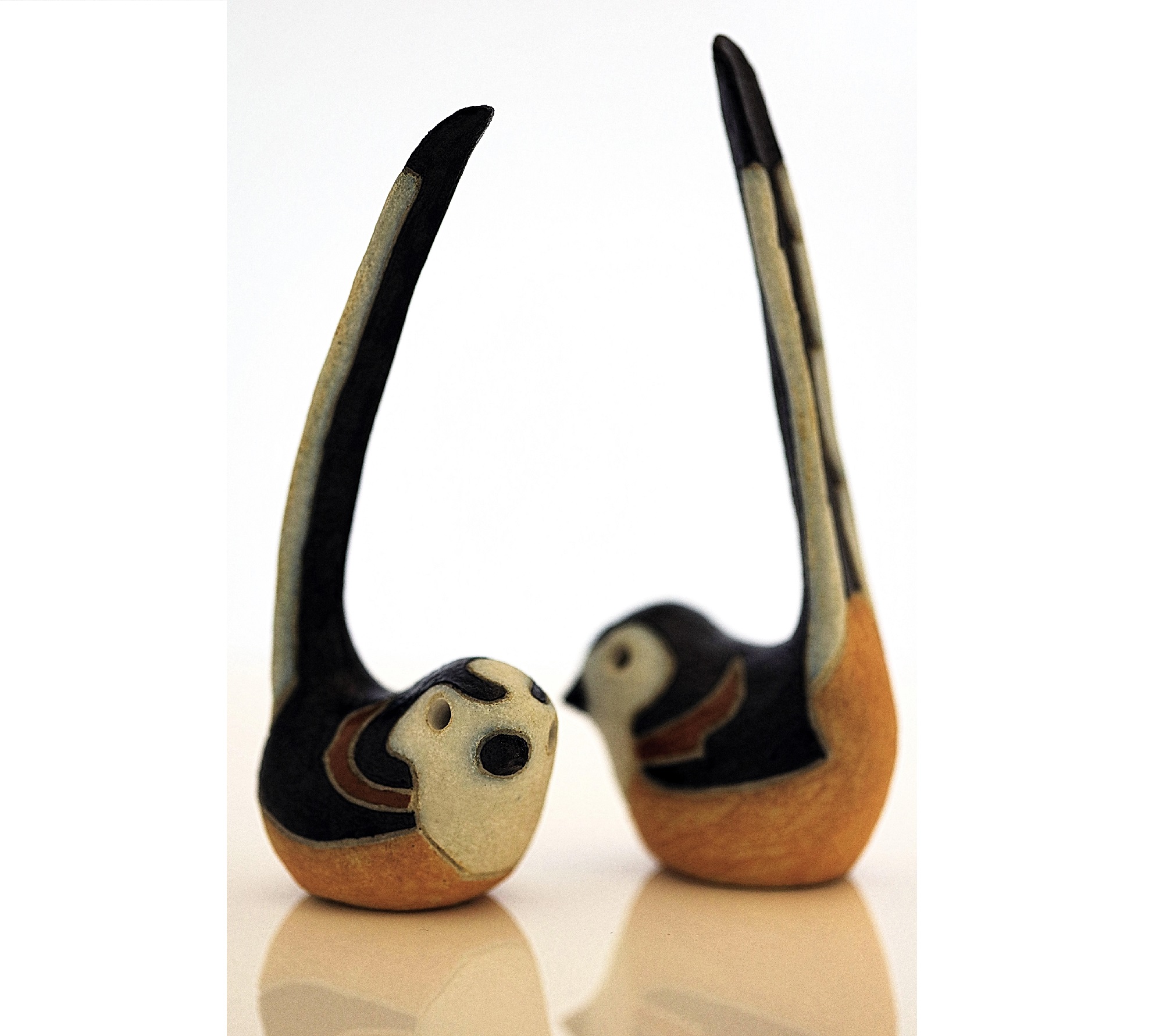
Long-tailed tits created in 1987 by Rosemary Wren and Peter Crotty.
These long-tailed tits, produced as a pair and just over life-sized, exhibit Rosemary’s tendency toward more exaggerated and romanticised forms.
All of Rosemary’s animal figures shown here are hollow. The rich detailing on the back of these tits’ tails show her attention to detail. As was Rosemary’s want, the eyes, as deep as they are, seem to peer out as the shapes of the tails curl and dance around each other.
They are two of the four pottery birds made in 1987 by Rosemary Wren & Peter Crotty, from life drawings of the birds.

Denise Wren is born in Albany, Western Australia, as Dorothy Tuckfield. She later changed her name to Denise.
Denise and her family leave Australia for England. They settle in East Molesey.
Denise learns to throw clay in Kingston-upon-Thames, under the designer Archibald Knox. In 1911 she had learnt how to throw pots by watching Mr Mercer, a flower pot maker from Norbiton Potteries.
Denise helps to set up the Knox Guild of Design and Craft at Kingston following Knox’s resignation. She marries fellow potter, Henry Wren.
Denise and Henry Wren design and build the Oxshott Pottery at Potters Croft, Oxshott. Here she and Henry make pots, teach students and experiment with designs, glazes and kilns, using coke and later gas to fire them. Denise also attends evening classes at Camberwell School of Art under Henry Hopkins at this time. Throughout the 1920’s and until the 1950’s, two-week summer courses were also regularly taught by the Wrens at the Oxshott Pottery.
Rosemary Wren is born at Oxshott.
Denise and Henry Wren organise the annual Artist-Craftsman Exhibition at the Central Hall, Westminster.
Denise Wren teaches evening classes at Teddington School of Art.
Denise Wren’s main production is hand-built and thrown earthenware decorated with slips and glazes for flowers. She also keeps animals and writes pottery manuals.
Denise begins to design textiles.
Rosemary Wren works with animals in the Women’s Land Army, as part of the home front in the Second World War. Denise Wren ceases potting for the duration of the war.
Denise is entered in the National Register of Industrial Art Designers as a textile designer, having ceased potting during the war years.
Denise studies ceramics and sculpture at the Guildford School of Art under Helen Pincombe, going onto the Royal College of Art from 1947-50.
Henry Wren dies. Denise and Henry’s daughter Rosemary takes over his workshop and begins working full-time with her mother from 1950.
Rosemary learns to make hollow forms at the age of 31, and also begins salt-glazing. She starts making hand-sculpted ceramic animals and birds the following year, in 1954.
Rosemary helps to found the Craftsmen Potters Association, based in London.
Denise Wren starts making elephant figures.
The lack of availability of suitable coke leads to an abandonment of the Wrens’ much favoured method of salt-glazing.
Rosemary Wren starts a relationship with Peter Crotty.
Denise Wren is made an honorary life member of the Craftsmen Potters Association that her daughter Rosemary helped to found.
Rosemary and Denise Wren move their pottery to Exeter.
Denise Wren dies in Devon. After her mother’s death, Rosemary moves the pottery to Hittisleigh in Devon.
Rosemary moves the pottery to Newton Abbot, Devon, and then again in the following year to Lustleigh, also in Devon.
Denise Wren’s role in the development of studio pottery in Britain is given recognition with the exhibition and related publication, ‘The Oxshott Pottery’ at the Crafts Study Centre, Bath.
Rosemary moves the pottery again, to Strathpeffer, in Scotland.
Rosemary Wren dies.
Interested in learning more about the wider history of ceramics? Take a look at some of these useful extra resources to discover its wider history in the UK and across the world.
Leave a comment
Let us know your thoughts on the Wrens of Oxshott and their pottery!You need to be logged in to comment.
Go to login / register